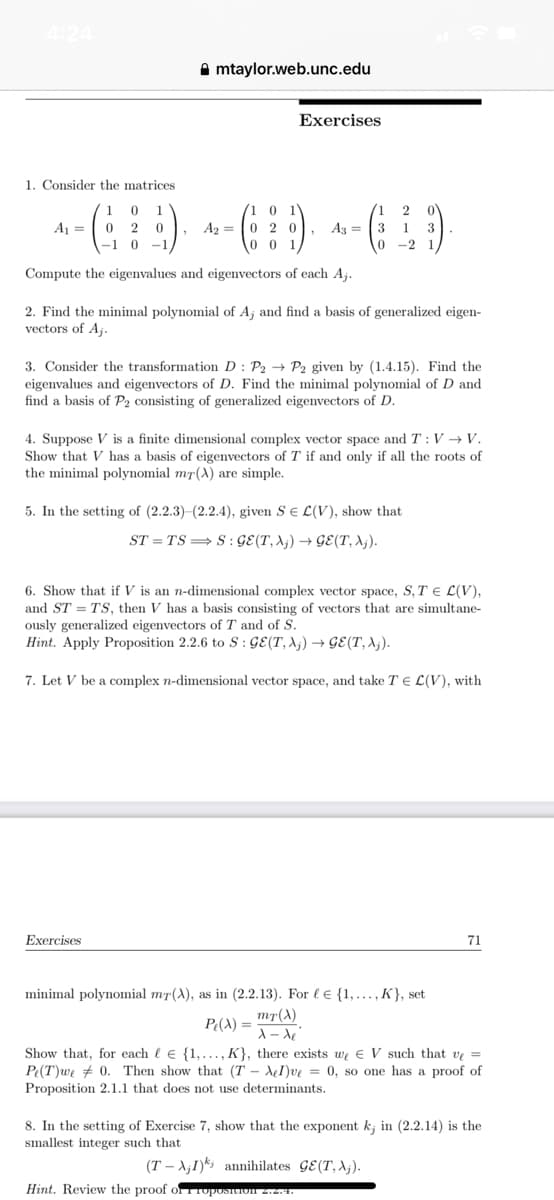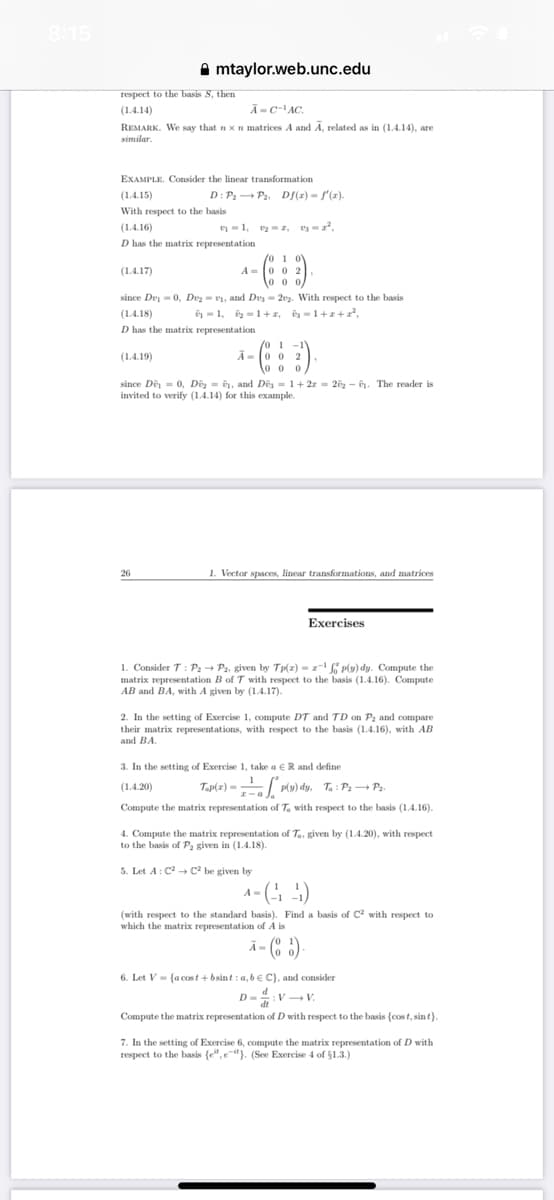3. Consider the transformation D: P2 P2 given by (1.4.15). Find the eigenvalues and eigenvectors of D. Find the minimal polynomial of D and find a basis of P2 consisting of generalized eigenvectors of D.
3. Consider the transformation D: P2 P2 given by (1.4.15). Find the eigenvalues and eigenvectors of D. Find the minimal polynomial of D and find a basis of P2 consisting of generalized eigenvectors of D.
Linear Algebra: A Modern Introduction
4th Edition
ISBN:9781285463247
Author:David Poole
Publisher:David Poole
Chapter5: Orthogonality
Section5.5: Applications
Problem 74EQ
Related questions
Question
#3 please

Transcribed Image Text:4:24
1. Consider the matrices.
mtaylor.web.unc.edu
1 0 1
2
A₁ 02
- (₁ ¦ ¦) + - ( ¦ ¦) ^ - ( ¹ )
0
A₂ = 020, A33 1
-1 0 -1
0-2
Exercises
Compute the eigenvalues and eigenvectors of each Aj.
2. Find the minimal polynomial of A; and find a basis of generalized eigen-
vectors of Aj.
3. Consider the transformation D: P2 P2 given by (1.4.15). Find the
eigenvalues and eigenvectors of D. Find the minimal polynomial of D and
find a basis of P2 consisting of generalized eigenvectors of D.
4. Suppose V is a finite dimensional complex vector space and T: V→V.
Show that V has a basis of eigenvectors of T if and only if all the roots of
the minimal polynomial mr(A) are simple.
5. In the setting of (2.2.3)-(2.2.4), given SE L(V), show that
ST=TS⇒S: GE(T, Aj) →GE(T, Aj).
Exercises
6. Show that if V is an n-dimensional complex vector space, S, T = L(V),
and ST TS, then V has a basis consisting of vectors that are simultane-
ously generalized eigenvectors of T and of S.
Hint. Apply Proposition 2.2.6 to S: GE(T, X₁)→GE(T, A₁).
7. Let V be a complex n-dimensional vector space, and take TE L(V), with
minimal polynomial mȚ(A), as in (2.2.13). For l {1,..., K}, set
mT(X)
P(X) =
x-de
Show that, for each le {1,..., K}, there exists we V such that ve =
Pe(T) we 0. Then show that (TAI)ve = 0, so one has a proof of
Proposition 2.1.1 that does not use determinants.
71
8. In the setting of Exercise 7, show that the exponent k; in (2.2.14) is the
smallest integer such that
(TAI) annihilates GE (T, Aj).
Hint. Review the proof of roposition 2.2.4.

Transcribed Image Text:respect to the basis S, then
(1.4.14)
Ã-C-¹AC.
REMARK. We say that n x n matrices A and A, related as in (1.4.14), are
similar.
EXAMPLE. Consider the linear transformation
mtaylor.web.unc.edu
(1.4.15)
With respect to the basis
(1.4.17)
D: P₂ P₂, Df(x) = f'(x).
(1.4.16)
D has the matrix representation
/0 1 0
A 002
0 0 0
since Dey=0, Dv₂=₁, and Des=202. With respect to the basis
-1, ₂-1+z₁ =1+z+2²,
(1.4.19)
1, 22, 2²,
(1.4.18)
D has the matrix representation
26
/0 1 -1
A-002
3)
0 0 0
.
since De = 0, D₂, and Des= 1+ 2z = 2₂-0. The reader is
invited to verify (1.4.14) for this example.
1. Vector spaces, linear transformations, and matrices
Exercises
1. Consider T: P₂ → P2, given by Tp(x)=z¹fp(y) dy. Compute the
matrix representation B of T with respect to the basis (1.4.16). Compute
AB and BA, with A given by (1.4.17).
2. In the setting of Exercise 1, compute DT and TD on P₂ and compare
their matrix representations, with respect to the basis (1.4.16), with AB
and BA.
3. In the setting of Exercise 1, take a ER and define
(1.4.20)
Tap(x)=P(y) dy, Ta: P₂P₂.
Compute the matrix representation of Ta with respect to the basis (1.4.16).
4. Compute the matrix representation of Ta, given by (1.4.20), with respect
to the basis of P₂ given in (1.4.18).
5. Let A: C² C² be given by
4-(4)
(with respect to the standard basis). Find a basis of C² with respect to
which the matrix representation of A is
- (85).
6. Let V (a cost+bsint: a,b C), and consider
D=:V V.
D-
Compute the matrix representation of D with respect to the basis (cost, sint).
7. In the setting of Exercise 6, compute the matrix representation of D with
respect to the basis (e",e-it). (See Exercise 4 of $1.3.)
Expert Solution
This question has been solved!
Explore an expertly crafted, step-by-step solution for a thorough understanding of key concepts.
Step by step
Solved in 3 steps

Recommended textbooks for you

Linear Algebra: A Modern Introduction
Algebra
ISBN:
9781285463247
Author:
David Poole
Publisher:
Cengage Learning

Elementary Linear Algebra (MindTap Course List)
Algebra
ISBN:
9781305658004
Author:
Ron Larson
Publisher:
Cengage Learning

Linear Algebra: A Modern Introduction
Algebra
ISBN:
9781285463247
Author:
David Poole
Publisher:
Cengage Learning

Elementary Linear Algebra (MindTap Course List)
Algebra
ISBN:
9781305658004
Author:
Ron Larson
Publisher:
Cengage Learning